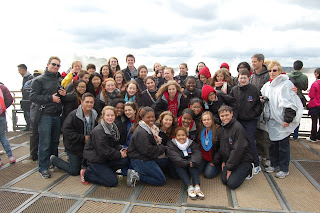BCS
Argentina
Iguazu Falls
Wednesday,
August 14, 2013

Twenty-five hours on the bus may seem like a very long time, especially when a cold is incubating among your fellow travelers, but the cramped, steamy quarters quickly evaporated from our memories with the arrival in Iguazu. There, host families awaited eager to tell us about the wonders of their home town. Just outside the town, a rainforest preserve guards one of the Seven Wonders of the World, where magnificent falls cascade from majestic heights, joining three rivers and three countries in a spectacle so vast no camera can do it justice.
While the town itself revolves primarily around the
ebbs and flows of tourism, el Parque
de Iguazu moves to the rhythms of nature. Our walk through the preserve
revealed not just the magnificence of the falls but also the life of the
rainforest. Tourists follow an elaborate network of wrought iron suspension
bridges through the rainforest and over the calmer waters of the falls to
lookout points that bring the power of the place to life. As we meander along
the path, we notice first the wildlife that fearlessly follows humans. Yellow-breasted
birds with black masks boldly alight on tourists’ fingers in search of
empanada crumbs. Families of coatis, a cousin to the raccoon, meander among the
tables of the snack stands sniffing out cookies inside our backpacks. Then
there is the wildlife that co-exists, seemingly oblivious to human presence. Long-legged
pipers stalk the grass and beach areas in search of insects, reminding Josh of
Cape Cod sandpipers. Cormorants preen themselves in the sun on the rocks that
extend beneath the iron suspension walkways that lead us through the rainforest.
Swallows build nests in the support rods of the path beneath our feet. And we
look out on the Swifts, little birds that flit like sprites in and out of the
waterfalls to their nests on the rocks within. They part the rapidly flowing
water as if it were nothing more than a curtain in their doorway. The ranger
tells us that deeper in the forest are also toucans, parrots, monkeys, colorful
snakes, ocelots, and occasional jaguars.
The water itself is high now, filling out the full
array of falls across the canyons. A rainy winter means that the island beach
at the center of the canyon is closed to tourists, its beaches immersed under
an additional seven meters of water from the Iguazu and Parana rivers. The rain,
though, also reveals the falls to us in their fullest glory. Our tour guide
tells us that most visitors see only the most dramatic of the falls because the
rivers seldom flow with such torrential force to fill out the full crown.
As we emerge from our jungle walk, we see first the
vapor of the falls at Devil’s Throat, where the water falls at up to 10,000
cubic meters per minute, making it the most well-known of all the Iguazu
waterfalls. This is the sacred falls where the Guarani Indians believed that god
and the devil battled for souls. Those who lived in perfect unity with nature
could safely navigate the upper shores of the falls; those who violated the
principles of harmony would plummet to their deaths, pulled down by the
inexorable force of the “devil’s throat.” Guarani legend also describes the jealous rage of a god
whose bride, Naipí, fled with her mortal
lover Tarobá in a canoe across the river. The god sliced the river in two, creating the
waterfalls but condemning the lovers to an eternal fall. With those stories
still resonating for us, the falls were suddenly upon us. The metal suspension
path came to a sudden stop at an overlook that had each of us certain we had
come upon not heaven exactly but that perfect Facebook photo that your friends
will never believe. A rainbow glistened through the mist as the clouds parted
for the first sunshine of the day. Jane remarked simply that rainbows and blue
skies always follow BCS.
Leaving Devil’s Throat, we headed around the crown
of the waterfall to see several other falls—just a few of the 275 discrete
falls within the Iguazu necklace. Ferns burst across our path and vines wrapped
themselves around the hand railings along the suspension trail, a profusion of
green that prevented us from seeing more than a few feet into the rainforest beyond
the path. The panorama of one waterfall after another broke our sense of
enclosure and still more rainbows offered more opportunities for singers to
proclaim, “the best Facebook photo ever!”
For Tal Zilber, BCS’s extremely talented composer
and accompanist, those Facebook moments were also opportunities to assemble the
chorus into rousing renditions of “Bring Me Little Water, Sylvie.” Tourists
stopped to listen as we sang loudly over the white noise of the falls, with Tal
capturing the moment for a DVD he is preparing for our singers at the end of
the trip. I heard one tourist exclaim to his group how lucky they were to
witness this impromptu concert in such a beautiful place. He was not the only
one. I imagine that many of these tourists posted their lucky encounters with
our singers at Iguazu Falls to their own Facebook pages, spreading the song of
“Bring Me Little Water, Sylvie” worldwide.
For the smallest sample of Iguazu Falls, try to
imagine the photos in our Shutterfly album full scale, embracing your entire
horizon. Then you’ll begin to feel the wonder of this place.
Shutterfly link:
Devil’s ThroatNatalie, Jennifer, and Guiverlly at Iguazu




Oh my God, everything is so beautiful we wish we could have gone. It seems like the long ride is worth it
ReplyDelete-Clara